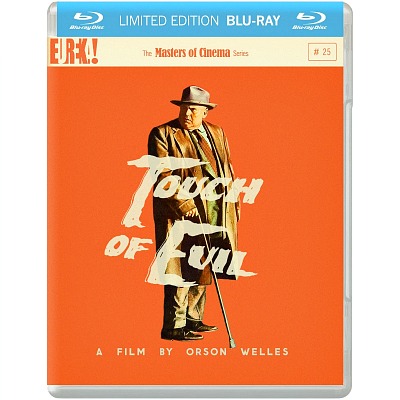If nothing else, the men and women of the Criterion Collection are known for adhering to purist principles in transferring older films to DVD and Bluray. Whatever and however a film in question looked to audiences when it first came out, this is how the Criterion team will present it — no ifs, ands or buts. But to go by information on a Criterion webpage for its forthcoming Bluray of Otto Preminger‘s Anatomy of a Murder (’59), the aspect-ratio brain police have wormed their way into Criterion and are imposing an Orwellian reassessment.
A movie that was very pleasingly and beautifully filmed with a protected aspect ratio of 1.33 to 1 — an aspect ratio which has been seen thousands of times on broadcast and cable TV, and which was presented on a 2000 Anatomy of a Murder DVD, and which the jacket copy for said disc proclaimed as “the original theatrical aspect ratio” — will be presented by Criterion next February with a 1.85 to 1 cropping.
In other words, Criterion is going to pull out its samurai blade and whack the living hell out of this film. I mean, that’s a lot of visual information being chopped out of the top and bottom of the frame. Despite those 1.33 framings being so visually pleasing, so elegant, so 1950s-looking, so boxy and fuddy-duddy, so “your grandfather’s living-room TV.”
But once again, as with Sony Home Video’s recent The Caine Mutiny Bluray, we’re going to see compositions on the Anatomy Bluray that feel sliced down and compressed and confined…like they’re in prison.
Except we were told a few weeks back that Sony’s restoration guy Grover Crisp cropped The Caine Mutiny Bluray down to1.85 because he’d reviewed the film’s original notes and logs about Edward Dmytryk‘s intended aspect ratio and that this was indeed the correct way to present it. (I still say “no” to this but that’s an earlier story.)

See the dog? You can see most of it. It’s almost a whole dog.

See the half-doggy? Do you GET IT NOW, fascists? Anyone who says that the half-doggy framing is better is in DEEP DENIAL and needs to be ignored or, better yet, slapped around.
Now, if Grover was technically correct in cropping Caine to 1.85 (and one assumes he based it on original notes and specifications, even though it was a highly questionable call from aesthetic perspective), how could Sony have approved or allowed jacket copy on the 2000 Anatomy DVD stating that 1.33 to 1 is “the original theatrical aspect ratio“?
What’s good for the goose should be good for the gander, no?
In other words, how and why could the Criterion people approve a 1.85 to 1 aspect ratio on their forthcoming Anatomy Bluray if the original aspect ratio (according to Sony Home Video) was 1.33 to 1?
The apparent answer is that Criterion is going with a 1.85 to 1 a.r. because they damn well feel like it. Because they’ve decided “to hell with it, this is what we’re going with and fuck off.” But either Sony was correct with its 1.33 proclamation in 2000 or Criterion is right about its forthcoming Bluray. They can’t both be right.
The answer, I believe, is the rule of simple expediency. A boxier aspect ratio worked fine with 1.37 to 1 analog TVs 11 years ago, but it doesn’t work with today’s 16 x 9 high-def flat screens. It seems to be that simple. I think it’s a flat-out travesty to whack Anatomy of a Murder down to 1.85, and I had the power and the influence I would lead a smelly unkempt mob into Criterion’s Manhattan headquarters, and we would refuse to leave until they re-think things and, knowing that the fascist mindset refuses to consider 1.33 any more, agree to at least crop it down to 1.66, which I would find more tolerable. Occupy Criterion!
Postscript: I’ve sent emails about this issue both to Sony’s Crisp and the Criterion people. But they both reside in very thick and deep concrete bunkers, so to speak, and they rarely discuss aspect ratio matters with press people. It is their refusal to come out in the sunlight and talk turkey, really, that gets me so angry about this stuff.


































